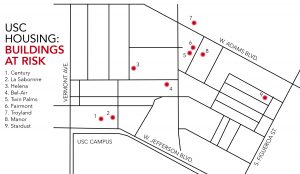Housing is susceptible to earthquakes
 At least nine USC Housing apartment buildings could be at risk of damage in a major earthquake and may require retrofitting, according to the Los Angeles Department of Building Safety. These USC buildings are just a few of more than 13,500 buildings in Los Angeles that could face a similar danger.
At least nine USC Housing apartment buildings could be at risk of damage in a major earthquake and may require retrofitting, according to the Los Angeles Department of Building Safety. These USC buildings are just a few of more than 13,500 buildings in Los Angeles that could face a similar danger.
LADBS identified thousands of “soft-story” buildings, which have “weak or open” bottom floors, as part of an ordinance issued by the City of Los Angeles requiring soft-story apartment building owners to perform retrofits. Typically these buildings include space for parking on the first floor, with the main portion of the building perched above it. According to the Los Angeles Times, these buildings are “vulnerable to violent shaking.”
This form of construction was popular in the 1950s and 1960s, the Times wrote, because the layout made it easier to fit parking, outdoor space and living space onto small lots. But because much of the building’s weight is supported by a few columns, the failure of these columns in an earthquake could cause the whole structure to collapse.
Lucy Jones, former earthquake safety advisor to Mayor Eric Garcetti told the Times that about two-thirds of the 49,000 apartment units damaged in the 1994 Northridge earthquake were located in soft-story buildings.
The USC-owned soft-story apartment buildings on LADBS’ list are spread throughout the North University Park area. According to data from the USC Housing website, these buildings are designed for use by a total of 718 undergraduate and graduate students. No on-campus buildings met the criteria to be on the list.
In the ZIP code 90007, a total of 136 addresses are listed by LADBS as potentially at risk. The listed USC-owned buildings are Bel Air Apartments, Century Apartments, Fairmont Apartments, Helena Apartments, La Sorbonne Apartments, Manor Apartments, Stardust Apartment, Troyland Apartments and Twin Palms Apartments.
The City of Los Angeles passed a law in 2015 mandating that owners retrofit these buildings, which involves adding steel frames to reinforce the bottom floor. Courtesy notices were sent in March, and official notices will be sent to building owners beginning May 2 through the end of next year, according to LADBS.
The list compiled by LADBS is not definitive, and some buildings on it may not require retrofitting. Owners have an opportunity to prove that their buildings are safe, but the city is offering online resources and in-person workshops to help those who do have to retrofit their buildings.
From the date they receive the order, building owners have two years to either submit plans for retrofitting or proof that the building doesn’t require modification. Final completion of retrofits must be completed within seven years of receiving the order. But retrofitting can cost “as much as $130,000,” the Times wrote.
USC is aware of the new law and the potential earthquake risk to some of its apartment buildings, according to University spokesperson Emily Gersema. USC Capital Construction is in the process of evaluating the buildings to determine if any retrofitting needs to be performed.
The United States Geological Survey has predicted an 85 percent chance of a magnitude 5.0 or greater earthquake in the Los Angeles area in the next three years.
